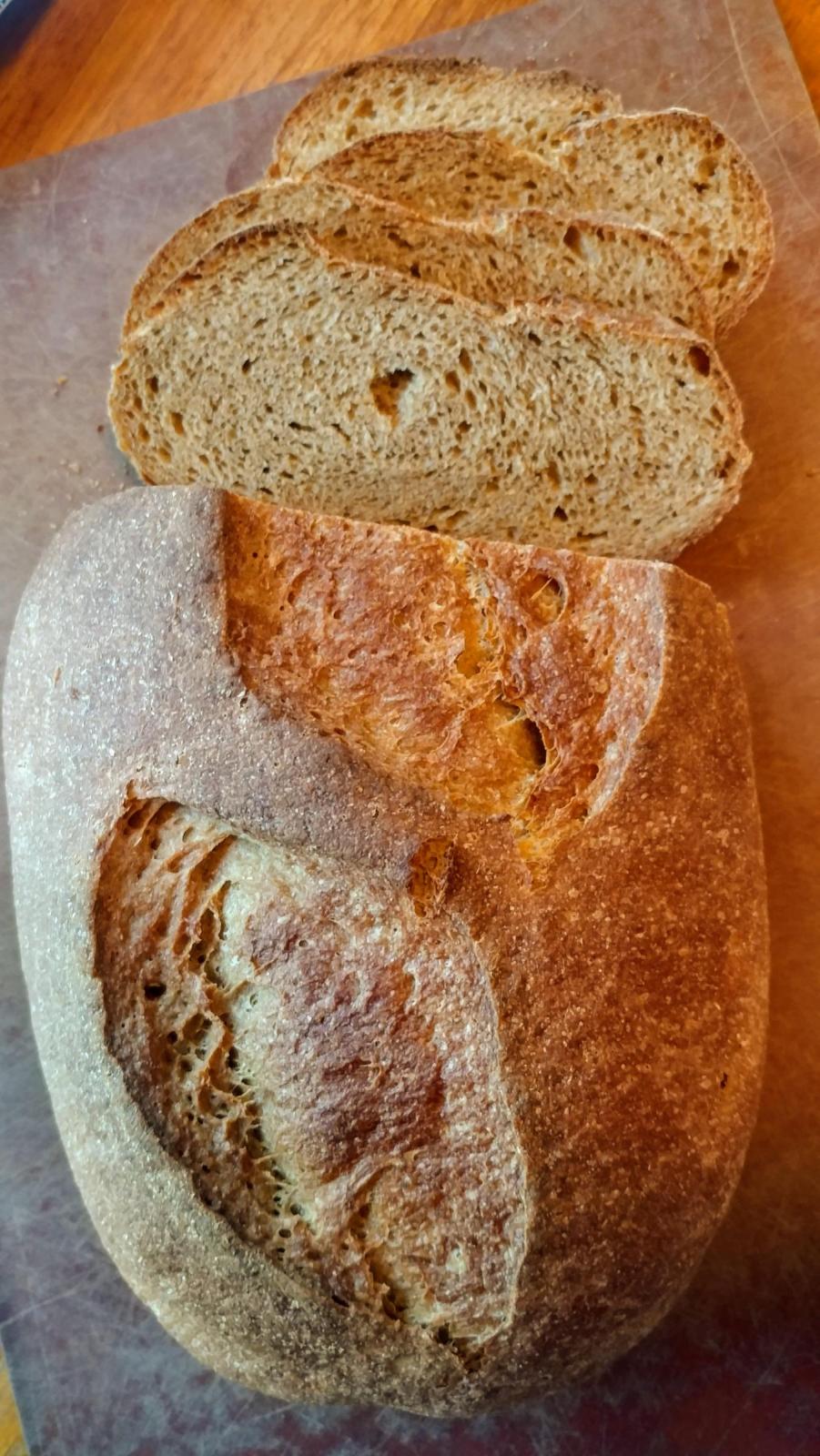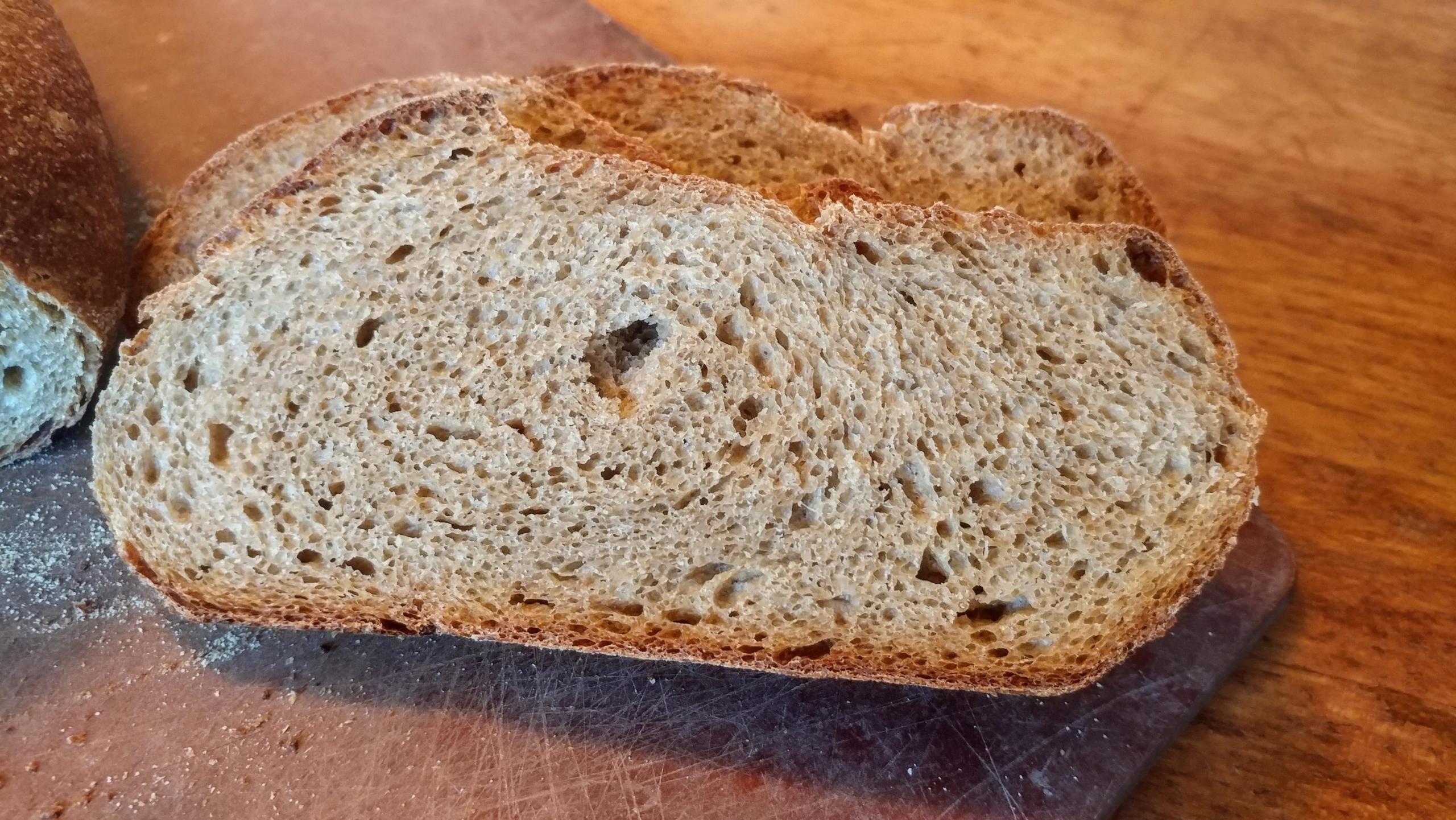
100% Whole Wheat Kamut with Raisin Yeast Water

This is my first venture into baking with Kamut in a while. In the past, I have found this flour challenging, as the gluten needs a lot of time to hydrate, and once hydrated it's a bit weak and very extensible. I adapted this recipe from AnnieT's Semolina Bread recipe here: http://www.thefreshloaf.com/node/20044/semolina-bread#comment-138273
I am delighted with this bread: it has a very thin, very crisp, delicate crust, a moist, tender interior, and a nice clean gentle wheat flavor.
I was concerned about the possibility of the gluten breaking down so I chilled the autolyse immediately in hopes of preventing too much early yeast and enzymatic action during the autolyse. This worked really well.
Here's what I did:
Poolish/Pre-Ferment:
- 100 grams yeast water,
- 100 grams hard red whole wheat flour
Mix, leave covered on the counter overnight, refrigerate until needed.
Autolyse
- 1 cup chilled yeast water,
- 115 grams fine-milled hard red whole wheat flour, sifted, bran discarded
- 190 grams fine-milled (twice milled) Kamut flour, plus more to dust
Dough:
- All of the pre-ferment
- All of the autolyse
- 9 grams salt
- 2 tablespoons extra virgin olive oil
Method:
- Mix flour, yeast water, and oil together to make a soft, sticky dough. Add more water if the dough isn't soft. Put immediately in the fridge to soak (autolyse) overnight.
- Take dough out of fridge, combine with pre-ferment and salt, and knead for about 5 minutes, until smooth and elastic. Add a little warm water while kneading if needed. Gently round, place into a lightly oiled bowl and let rise in a warm location until ripe, about an hour and a half.
- Turn out, top down, onto a lightly floured surface. Slide your lightly-floured hands, palm down, under dough and lift and gently stretch the dough out, like a pizza dough. Lay the stretched dough down on counter and stretch the edges out too, into a square-ish shape. Press out any large air bubbles. Fold in thirds from the sides, and then again from the top and bottom (letter fold.)
- Place back in bowl, seam down, and let rise 20 minutes or so. Repeat step 3 and let rise again for 20 minutes.
- Preheat oven to 425. Shape dough into a batard. Let dough rise until visibly expanded, about a half hour. Don't let it get all the way to the very tender quivery, fully-inflated stage. Place in clay baker, brush off excess flour, score, spray heavily, cover, and place in oven.
- After 20 minutes, remove cover and bake another 20 minutes or so, until loaf is browning at edges and the internal temperature registers around 210 Fahrenheit.

Pictures show the hole the thermometer made, alas.



Comments
You wouldn’t know that Kamut was difficult to work with by your loaf. Excellent crumb and oven spring for 100% whole Kamut Jess. The crust has great colour.
Benny
Crust and crumb, and I love the aesthetic of your scoring. I will get to experimenting with raisin water. How does it affect the taste to levain this way compared with standard sourdough?
Thanks, Benny! It isn't properly 100% kamut because there's about 1/3 sifted hard red in there for added strength. I'm only sifting it because I want the color and flavor of the kamut to shine through: if I had any hard white I would use that and skip the sifting.
Alison, the flavor profile of the yeast water levain is very similar to commercial yeast, except without the 'yeasty' taste/smell. It isn't sour at all. Some people report that it gives a sweet or fruity scent to the bread but I can't perceive that in this (my first yeast water) loaf. Maybe my sniffer isn't sensitive enough.
I have seen people on TFL (Dabrownman I think) recommend combining a sourdough levain with straight yeast water in the dough to get a milder, less sour version of sourdough. I haven't tried that yet. I'm only speculating but I think the idea is that the addition of the yeast water increases the yeast-to-lactic acid bacteria ratio, speeding up the proofing time and causing the bread to proof before as much acid flavor can develop (sort of like combining sourdough and a pinch of yeast.) I may try that with my next sourdough loaf.
It is fun to play with yeast water. I'm switching mine to apples since organic raisins are really expensive, and organic apples are relatively cheap. Here is a picture of my transitioning raisin/apple yeast water and a closeup of the bread crumb.